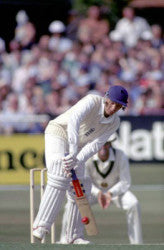Gower Power to Customer Power
Gower Power to Customer Power
By Alan Lewis NDT F inst G,

I still remember as a young lad, sitting watching the test match on the BBC and seeing a young batsman walk to the crease to begin his first innings for England. His name was D. I. Gower. He timed his first ball through the covers for four with effortless power, which went on to become his trade mark. What David Gower did, as all good batsman do, was to use the pace from the bowler, and off the pitch, to do the work for him.
So how do we get pace in cricket pitches? Key factors that create a good cricket square are as follows;
1. A pitch profile made from a clay loam with no layering or fractures within it.
2. A dense and strong rooting system.
3. The ability to control moisture content within the profile: i.e. artificial watering/covering.
4. The amount of organic matter within the profile.
5. Preparation techniques: i.e. rolling, cutting.
6. Climate conditions.
7. The time and resources to complete the above.
Some Groundsmen are fortunate enough to have all these in place. However, let us consider the first point listed, and how selecting the correct loam for your cricket square can be a minefield. One application of a loam with different characteristics, will effect your square considerably.
What are the factors, which control the performance of cricket loams?
1. The percentage of sand, silt and clay within the loam measured using Particle Size Distribution, 'PSD'.
2. The amount of organic matter.
3. Binding strength.
4. Shrinkage rates.
5. The loams pH reading.
I am particularly interested in the percentage of clay within the loam and which clay type makes up that percentage. We know that sand is important for cohesion among soil particles, and a high silt soil will create problems with binding. More research is required into the qualities of silt within loams. So why do cricket loams with similar percentage of clays have different qualities? For example, the three loams below each have a clay content of between 27% and 31 % and are commonly used.
|
LOAM |
CLAY % |
STRENGTH % |
SHRINKAGE % |
|
A |
29 |
76.5 |
18.1 |
|
B |
31 |
56.0 |
20.4 |
|
C |
27 |
52.2 |
13.4 |
Looking at the figures above, a loam with clay content of approximately 30% can vary dramatically in its strength and shrinkage characteristics. You could have a loam that has strength of 76.5% or another almost a third weaker at 52.2% and that shrinks 20% or 13.4%. The skill to match these loam qualities, to that of your own loam on existing squares, is vital.
The shrinkage figures may not appear to be significant, however it is important to remember that if top dressing is not ameliorated into the surface correctly, and it shrinks at a different rate to your existing square, root breaks and layers of organic matter will form within the profile.
It comes as no surprise that we have problems with layered profiles, root breaks and pitches that lack pace and bounce. On top of that, a number of loam suppliers farm an area for its loam, so the quality of the loam can vary over a period of time. Other loam companies blend the dressing, using clay as the base for the mixture and adding lighter loams to adjust the contents. With this method, the standard of loams can be maintained for a number of years. There are still some very poor cricket loams on the market, with clay content as low as 14%, slit as high as 60% and organic matter over 10%. Why work for hours scarifying to remove organic matter from the surface, only to add it back in by the bag full?
Groundsmen, as the customers, need more choices and should ask for more information from the loam suppliers e.g. PSD, strength and shrinkage information. It would be preferable to have this information printed on the bag, to assist in selecting the correct loam.
Regular soil tests should be carried out to establish the quality of your loam. This will help to ensure that you get good compatibility and therefore reduce the possibility of layering. If you are content with your pitches performance, continue to work with the same loam. Do not become a victim of fashion and change loams without investigation and a good reason.
I am continuously carrying out research into how mineralogy effects the compatibly of clay loams used in cricket pitches and will update Pitchcare with the necessary information. If you need help in loam selection or other pitch issues please feel free to e-mail me at. al@totalturfsolutions.co.uk Good Luck! Alan Lewis NDT F inst G, Director of Total Turf Solutions Ltd.
Picture of D Gower provided by Cricket World.com
